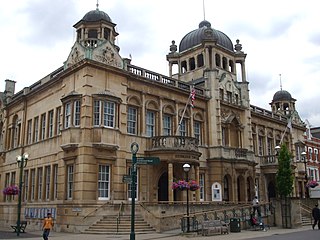
Ilford is a large town in east London, England, 9 miles (14 km) north-east of Charing Cross. Part of the London Borough of Redbridge, Ilford is within the ceremonial county of Greater London. It had a population of 168,168 in 2011, compared to 303,858 for the entire borough.

The London Borough of Redbridge is a London borough established in 1965.

Roding Valley is a London Underground station situated in Buckhurst Hill in the Epping Forest district of Essex, straddling the boundary between that council and Greater London. The station is on the Hainault loop of the Central line between Chigwell and Woodford stations. However, geographically it is midway between Woodford and Buckhurst Hill stations. It is located between Station Way and Cherry Tree Rise. Since 2 January 2007, the station has been in Travelcard Zone 4.
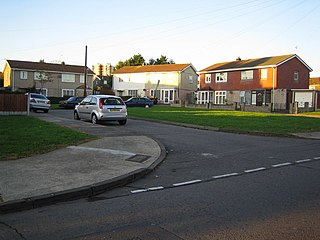
Hainault is a large suburban area in northeast London, England, in the London Borough of Redbridge, 12.5 miles (20.1 km) northeast of Charing Cross. Most of the housing in Hainault was built by the London County Council between 1947 and 1953. Originally spanning the parishes of Chigwell, Dagenham, and Ilford, in 1965 the estate was combined in a single London borough and became part of Greater London.
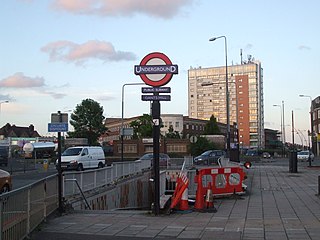
Gants Hill is an area of Ilford in East London, England, within the borough of Redbridge. It is a suburb 9.5 miles (15.3 km) east northeast of Charing Cross. It lends its name to a central roundabout where five roads meet.

Grange Hill is a London Underground station on the Central line which lies in the parish of Chigwell in the Epping Forest district of Essex. The boundary with the London Borough of Redbridge is immediately to the east of the station buildings. The station is between Hainault and Chigwell stations. The station has been in Travelcard Zone 4 since 2 January 2007.
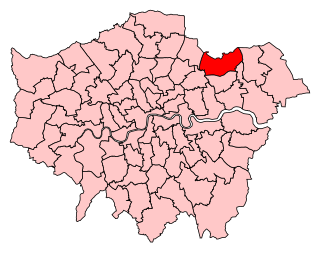
Ilford North is a constituency created in 1945 and represented in the House of Commons of the UK Parliament since 2015 by Wes Streeting of the Labour Party.

Gants Hill is a London Underground station in the largely residential Gants Hill district of Ilford in east London. It is served by the Central line and is between Redbridge and Newbury Park stations on the Hainault loop. It is in Travelcard Zone 4. It is the easternmost station to be below ground on the London Underground network and the busiest on the Hainault loop.
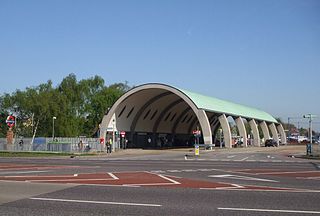
Newbury Park is a London Underground station in Newbury Park, Ilford, East London. It is between Barkingside and Gants Hill stations on the Hainault loop of the Central line, in Travelcard Zone 4. The station was initially opened by the Great Eastern Railway on 1 May 1903 and subsequently transferred its services to the London & North Eastern Railway due to the amalgamation. Underground trains only started serving the station on 14 December 1947, operating via the Gants Hill tunnel. The line was extended to Hainault on 31 May 1948. The Grade II listed bus shelter designed by Oliver Hill opened on 6 July 1949. Lifts were fully installed at Newbury Park in November 2018 to provide step-free access to the station, approximately 10 years after TfL abandoned the project.

Barkingside is a London Underground station on the Central line. It is on the eastern edge of Barkingside in east London at the end of a cul-de-sac off Station Road. The station is next door to the home of Redbridge F.C. It is between Newbury Park and Fairlop stations and has been in Travelcard Zone 4 since 2 January 2007.

The London Borough of Redbridge, one of the north-eastern peripheral London boroughs, has within its boundaries parts of two large open spaces: Epping Forest and Wanstead Flats. Apart from many smaller parks, gardens and sports grounds, the following are the main open spaces in Redbridge:

Hainault Forest was a large wooded area in the English counties of Essex and Greater London which was mostly destroyed after 1851. Popular outrage at the destruction of most of the forest was an important catalyst for the creation of the modern environmental movement.
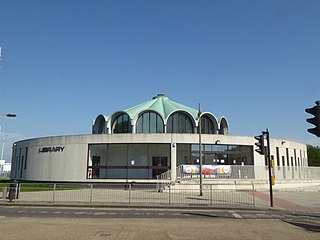
Barkingside is an area in Ilford, in the London Borough of Redbridge. It includes the major road junction of Fullwell Cross which also gives its name to the locality near that roundabout. The area is situated 10.6 miles (17km) north east of Charing Cross. Prior to 1965, it formed part of the borough of Ilford in the historic county of Essex.
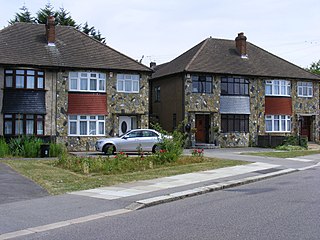
Clayhall is a district of Ilford in the London Borough of Redbridge in east London, England. It is a suburban development. The name is derived from an old manor house that stood within the current area. It is first mentioned in a document of 1203 as being an area of land granted to Adam and Matilda de la Claie by Richard de la Claie. The estate probably remained in the hands of this family for about one hundred years, after which it passed through several hands, without ever being positively identified by name, until in a conveyance of 1410 it is described as the manor of Clayhall.
Newbury Park is an area of Ilford in East London situated in the London Borough of Redbridge east of Gants Hill. The main road is the Eastern Avenue (A12), which until the 1920s was a country lane called Hatch Lane. The main landmark in this area is the tube station whose post-war bus shelter received a Festival of Britain award in 1951. The shelter was designed by architect Oliver Hill in 1937.
Royal Air Force Fairlop or more simply RAF Fairlop is a former Royal Air Force satellite station situated near Ilford in Essex. Fairlop is now a district in the London Borough of Redbridge, England.
The Hainault Loop, originally opened as the Fairlop Loop, is a 6.5-mile (10.5 km) branch line of the Great Eastern Railway (GER). It once connected Woodford on the Ongar branch to Ilford on the Main Line, with an eastward connection for goods, excursions and stock transfers to Seven Kings. The loop opened to freight on 20 April 1903 and to passengers on 1 May 1903. In 1923, the GER was "grouped" into the London & North Eastern Railway (LNER), who provided passenger services until December 1947. After this date, the route was electrified for London Underground services from both the Woodford and Leytonstone directions, the link to Ilford closed, and today it forms the greater part of the Hainault Loop on the Central line, having been served by Tube trains since 1948.

Woodford is a town in East, London, within the London Borough of Redbridge. It is located 9.5 miles (15.3 km) north-east of Charing Cross. Woodford historically formed an ancient parish in the county of Essex. It contained a string of agrarian villages and was part of Epping Forest. From about 1700 onwards, it became a place of residence for affluent people who had business in London; this wealth, together with its elevated position, has led to it being called the Geographical and social high point of East London. Woodford was suburban to London and after being combined with Wanstead in 1934 it was incorporated as a municipal borough in 1937. It has formed part of Greater London since 1965 and comprises the neighbourhoods of Woodford Green, Woodford Bridge, Woodford Wells and South Woodford. The area is served by two stations on the Central line of the London Underground: Woodford and South Woodford.

Aldborough Hatch is an area in Ilford in east London, England, within the London Borough of Redbridge. It is located 11.1 miles (18 km) east-northeast of Charing Cross. It is a semi-rural locality situated to the east of Barkingside and Newbury Park.
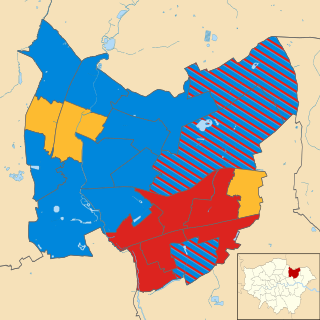
Elections for Redbridge Council in London were held on 2 May 2002. It was a part of the wider 2002 London local elections. The Conservatives won 43% of the vote in the district. The turnout was 34.26%, a decrease from the 36% seen in the 1998 London local elections.



















